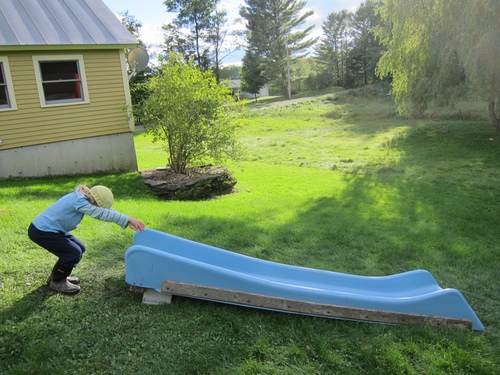This moment: On the Farm
/From Soulemama: A Friday ritual. A single photo - no words - capturing a moment from the week. A simple, special, extraordinary moment. A moment I want to pause, savor and remember.
From Soulemama: A Friday ritual. A single photo - no words - capturing a moment from the week. A simple, special, extraordinary moment. A moment I want to pause, savor and remember.

In the winter garden, through the falling snow
Stars are gleaming, streaming, gleaming,
Down to earth below.
I'm not sure who wrote this (Nancy Foster?), but we used to sing it it Katherine's class and it has been in my head all day... and in the back of my mind I've been trying to figure out what to do with our garden before winter.
The family who lived in this house before us left a beautiful flower garden, and as recently as last week, we filled a vase with the last of the fall flowers. But after several nights in the teens, the green has finally turned to brown. Except for the pansies. They are a hardy bunch.
I've been asking friends what they do to their flower gardens in the winter, and everyone has a slightly different answer. I guess it is a personal decision: some like to cut down all the stalks, neat and tidy; others have very specific plans - straw covering for this, leaf covering for that, cut this down, leave that standing - depending on the plant; and a few simply do nothing. I sort of assumed I would fall in the neat and tidy camp (seemed like a nice middle ground that wouldn't require too much thinking on my part), so this afternoon I went out with my clippers to get things in order. I cut a few things here and there, but found myself hesitating.
As I hummed the Winter Garden song, I realized I wanted some sort of reminder of what was here all summer. Plus, the crunchy brown stalks are interesting in their own way. I bet they'll look quite nice in the first snow, before they are buried under what I hope will be many feet of snow (hey, if it's going to be cold and grey, then I want snow!)
So for now I'm going to leave the flower gardens as they are and see what happens.


And then it snowed! So here is how it looks in that first snow.



This past year has been an interesting one... wonderful because we made it to Vermont and love it here, and challenging because getting here meant a lot of changes. Probably the biggest change was my becoming the working parent and Dave becoming the stay-at-home dad. I haven't written much about that side of life, but here is an essay I wrote about our role reversal.
Role Reversal
When my husband, Dave, and I were in the Peace Corps, planning our future together, he warned me he had no idea what he wanted to do when he grew up. I replied with certainty, “That’s fine, I plan to get a high paying job so you can do whatever you want.” Then I ended up going back to school for nearly ten years.
I tried out that high paying job when we first returned to the U.S., but I only lasted nine months before I couldn’t stand making one more dentist appointment for my slimy boss. I decided at that point I would never again work for someone who thought he was superior; I applied to grad to school in hopes of getting out of having a real job for as long as possible (while promising Dave I would be done in two years and then get a high paying job I would like, in Vermont).
The reality of our post-Peace Corps plan was that Dave supported me through grad school and we had three children. I did end up getting a job, but mostly I was home with the kids, and we hadn’t made it to Vermont. We were still living in D.C. when our oldest daughter reached kindergarten last year, Dave and I decided it was time to move; we wanted to be in our final landing spot before she started first grade. So we both asked our respective bosses if we could telecommute. Dave’s said no. Mine said yes. Turns out that was all we needed and within a few months, we left our lovely city neighborhood of nearly ten years and moved to rural Vermont. I became the full-time working parent and sole breadwinner, and Dave became the stay-at-home Dad. Finally, I had come through on my promise. I had the high (relatively speaking) paying job, and Dave was free to figure out what he really wanted to do.
This role reversal has been an adjustment. I used to know all the details about the kids’ day: what they liked for snack, whose knee got scraped, who napped and who had a meltdown. Now when I come home from work I feel like my arrival is disrupting a scene I wasn’t written into. I sit down to draw with my six-year-old, not knowing she has been asked to put her books away three times and still hasn’t done it. I brush past my four-year-old to listen to a phone message, not knowing she’s been waiting for me by the door for thirty minutes. I cut my one-year-old’s quiche into bite-size pieces and then feel admonished when Dave tells me she hasn’t needed her food cut for weeks now. I feel out of sync with my children and admit to myself it would be easier to work late than to come home early. The guilt of this realization sits heavily on the weight of responsibility, and I have to fight the urge to throw up my hands and snap, “I guess I’m just not the mom anymore!”
It’s difficult for Dave, too, to be home all day with the kids and the monotony of daily household chores that never amount to any final product of accomplishment. Finding chunks of time to focus on a new career takes creative energy that he doesn’t always have after a day at home with three young children.
But the reversal has also been as enlightening as it has been challenging. For one, I am beginning to understand that having to work and getting to work are two very different things. I like my work slightly less knowing I don’t have a choice, but take greater pride in it knowing its value to the family.
Finding guilt-free time for myself is also far more difficult than I expected. It was easy to head out the door for a run when Dave came home from work; after all, he hadn’t seen the kids all day and would surely be grateful for an hour alone with them while I took a little break. Now, slipping out for a run not only adds an hour to Dave’s already long day, but takes away an hour from my already limited time with the kids. The time-at-home disparity of a one-working-parent set-up does not favor personal time for the working parent, a concept I didn’t grasp when I wasn’t the one working.
However, the piece I never fully appreciated is the responsibility the sole working parent carries. Everything is wrapped up in my job – our income, our health insurance, our retirement, and even our vacation schedule. I didn’t give Dave nearly enough credit for the burden he carried for all those years.
It still comes up in conversation every so often, my early promise of a high paying job. For years it was a question Dave asked in jest, “Tell me again, when are you going to get that high paying job you promised?” Now the conversation about that promise, which we have both fulfilled for each other, carries a deeper understanding and mutual respect for the other’s role in the family.
From Soulemama: A Friday ritual. A single photo - no words - capturing a moment from the week. A simple, special, extraordinary moment. A moment I want to pause, savor and remember.

As I sit here by the woodstove, eating my children’s Halloween candy and sorting through pictures of their costumes to send to the grandparents, I can’t help but think how much I love Halloween.
There has been a lot of discussion among parents over the past few weeks about Halloween traditions, and surprisingly, many parents expressed their dislike of the holiday, claiming that the focus on super heroes, princesses, and candy pretty much represents the worst of our consumer-based, corn syrup-soaked society. Of course other parents countered that they love the creativity that goes into making costumes and the joy their children get out of carving pumpkins, dressing up and trick-or-treating.
But the most interesting conversation I had about Halloween was with one of Katherine’s teachers. He noted the duality that exists in humans – the animalistic, gluttonous side and the kind, virtuous side – is mirrored in this holiday, with Halloween representing avarice and All Saints’ Day representing morality. This is the same duality we see in literature throughout history: the struggle between the wicked and pure characters that portrays every individual's inner struggle between good and bad, right and wrong.
In many countries, All Hallows’ Eve is nothing more than the night before the true holiday, All Saints’ Day. In Poland, and probably many European countries, families spend All Saints’ Day decorating graves with flowers and candles, and return at dusk to walk through the cemetery. When I lived in Poland I joined my friends in this tradition, and I don’t believe I’ve ever seen a more beautiful, peaceful sight. The entire cemetery glowed with thousands of candles as people walked the paths quietly and thoughtfully. Catching glimpses of the writing on the gravestones in the twinkling light, wondering about the woman who had lived to be 80, or the child who had lived to be 2 over a hundred years ago, helped put day-to-day life in perspective. The words that come to mind when I think of that experience are peace, warmth, and comfort. The celebration of All Saints' Day meets the virtuous inclination of humans.
In contrast, Halloween in the U.S., with the overload of candy, certainly gives in to the gluttonous side of human nature. We would probably do well to tone down Halloween (as I unwrap my fourth candy bar…) and balance it out with a reverent celebration of All Saints' Day.
But still, I love Halloween: the decorations, the costumes, the pumpkins, the candy... and even though I find the concept of duality fascinating, the part I love the most is the way we let go of our fear (which is no small feat in our fear-based society) and not only open our door to the whole community, but send our kids out to collect treats from complete strangers. It is a day of mutual understanding that everyone is welcome to join. I think that is pretty awesome.
Finally, a picture for the grandparents.

From Soulemama: A Friday ritual. A single photo - no words - capturing a moment from the week. A simple, special, extraordinary moment. A moment I want to pause, savor and remember.

The other day, I sat down with a cup of tea and my laptop,
ready to take advantage of all three kids resting, but needed a light topic for
the few minutes that I had. I asked Dave if he had any ideas and he promptly
answered, “What to do about impractical gift requests from kids – like when
your six-year-old wants a pogo stick for her birthday even though it will
likely be snowy and she won’t be able to use it for several months.”
Ah, yes. This is a dilemma for us. Katherine has been asking for a pogo stick for months. Not too long ago she even said, “When I get a pogo stick, stilts, and a booster seat, I'll be perfectly happy because I'll have everything I want.” Well, she got a booster seat and she seemed to forget about the stilts, but we still hear about the pogo stick regularly.
The problem is that it’s just not practical. First of all, it’s a one-trick pony, which pretty much violates our golden rule of purchasing: No one-trick pony purchases. Especially when it comes to toys. Of course, exceptions can be made – like the milk frother for my latte – but rarely for toys. One-trick ponies lead to clutter (see kitchen counter). Second, her class will soon begin pogo-ing at recess, so she’ll get her chance then, no need to have it at home, too. In fact, she already gets to pogo at school. Third, her birthday is in winter, so she won’t even be able to use it until April or May (and there is no way we’re going to have her pogo-ing around the living room). Finally, we have other ideas in mind for her, things she’ll really like and that she can enjoy all winter.
But, she really wants a pogo stick. So here we are trying to find that balance between keeping things practical and giving in to a plain, old six-year-old wish.
From Soulemama: A Friday ritual. A single photo - no words - capturing a moment from the week. A simple, special, extraordinary moment. A moment I want to pause, savor and remember.

I admit to feeling a bit prickly when my six-year-old’s friends casually call me “Karen”. My initial reaction is to haughtily ask them if they don’t mean “Mrs. Vatz”, but then an even stronger aversion kicks in and stops me. I am not Mrs. Vatz. That was my mom, and she was much older then than I am now... Actually, she was several years younger than I am now. But still, “Mrs.” sounds so old, so outdated, and I don’t relate to that title at all.
When I was a kid, we all called our friends’ parents “Mr.” and “Mrs.”, just as my parents’ did when they were kids. In fact, my dad still refers to his boyhood friend’s mom with the title “Mrs.” The formality between a child and an adult was a pretty stable cultural norm. But now, I don’t know any kids who use “Mrs.” and “Mr.”, other than to address their schoolteachers. It seems that norm has dissolved, leaving an awkward lack of formality where there should be at least something to indicate a difference in age and social rank between children and adults.
This new norm – or lack thereof – is difficult for me as a mom. It feels too formal to insist my children use “Mrs.” and “Mr.” – I know I don’t want to be addressed that way. But I’m not comfortable having my four- and six-year-old call adults by their first name. I want some degree of respect embedded in my children’s speech towards other adults. Beyond a marker of respect, using some sort of title establishes that the adult is a responsible being with whom a child can simply be a child. In other words, a title offers a sense of authority that I think children find reassuring. I also think children, at least my children, appreciate the distance it establishes, as though it relieves them of the pressure to hold their own socially with adults before they are ready. But perhaps I am reading too much into it, or perhaps I am just more traditional that I thought.
Still, I find myself searching for a contemporary alternative to “Mrs.” and “Mr.” At first glance, the “Miss + first name” option seems like a nice middle ground. I could accept being “Miss. Karen”, and my kids would be comfortable calling my friends “Miss. ____”. However, I’ve found the population to be split on this – with half my friends embracing it as the right balance of casual-formal, and the other half deeming it a lame pseudo-formality that comes across as too “pre-school”. Therefore, I’ve ruled out that option; it’s just too confusing for me – let alone for my kids – to remember who prefers “Miss” and who doesn’t.
So for now, and as long as our society is lacking a widely-accepted title for children to use when addressing adults in their life, I am forced into a too casual norm, with the first-name basis being the least awkward option. But I’m not entirely happy with it.
What do you have your children call other adults? Do you agree that no title is too casual? Or are you comfortable - even happy- with this norm? I'd love to hear how others feel about it!
From Soulemama: A Friday ritual. A single photo - no words - capturing a moment from the week. A simple, special, extraordinary moment. A moment I want to pause, savor and remember.

A friend and colleague of mine, Sarah, works with parents of children with special needs. Because the work Sarah does is so important and because she does it so well, I would like to share with you a little about her and her services. She is a wonderful resource, and as you'll see below, she is passionate about working with exceptional families. You can also check out her website at Guiding Exceptional Parents.
------------------------------------------------------
Tell us a little about your business.
I support families in two related ways: (1) Care coordination for children with special needs (especially learning disabilities, ADHD, and autism; I'm also an expert in helping twice exceptional kids who are both gifted and learning disabled), and (2) as a Relationship Development Intervention (RDI) consultant.
The goal of the care coordination is to help families to appropriately set their priorities and to give them the tools they need to get the best possible support and care for their child.
RDI is an individualized training program that helps parents learn how their child's mind works. By working closely with the family, I can help parents learn how to create meaningful learning opportunities in everyday situations so their children can acquire the social-emotional skills fundamental to making and maintaining meaningful relationships.
How did you come to start your business?
I have two kids with learning disabilities. When our oldest son's kindergarten teacher first told us "something was up" with him, we had no idea what to do. We got a neuropsychological evaluation, but were at a loss regarding how to follow up and find good clinicians to work with him. We didn't understand how to prioritize. We didn't realize that the fix would not be quick. And there was no one to help us do these things. Each person had their own view of the world - the speech language pathologist was worried about our son's language and lack of social skills, the developmental pediatrician was worried about his ADHD and his executive functioning, the physical therapist was worried about his motor coordination.
Which was most important? What treatments were actually effective? Which were a waste of money and time? How should we evaluate?
Having navigated all this for two children now, I want to make sure that no parents feel as lost as my husband and I did with our oldest son. I have the knowledge and resources to help others; I want to put it to good use!
One of the the therapies we did with our kids that was incredibly effective at restoring a more normal family dynamic was RDI. It helped us so much, I decided to get certified so I could help other families.
What do you hope to bring to your clients?
A deep understanding of how the schools work, what therapeutic options are available, what works, and how to evaluate a new approach. I can help parents who are wondering about their child who seems "different" - by determining how to help them figure out their child, or, if they have a diagnosis, by pointing them to effective therapies and clinicians. My approach is family-centered; my goal is to help family members learn how support and nurture each other.
My goal is to teach parents the skills they need to navigate the medical, educational, and social systems effectively so they no longer need my support. Education and knowledge are power - I can provide parents with the resources they need to support themselves.
What is your favorite part about your job?
Many parents are confused, lost, and scared when they first seek my help. Many are in crisis. I love watching these amazing people grow as they learn how to help their children, and how to effectively navigate the system. The most rewarding part, by far, is when I realize that these parents who were once so lost now have the confidence and knowledge to help others.
What do you envision for your business in the future?
There are "Elder Care Coordinators", but there's no equivalent position for a person who can help coordinate care for kids with learning disabilities and other special needs. I would love to start a revolution, so parents everywhere would know that there's someone who can help them coordinate their care across all domains - medical, educational, and social.
What inspires you?
The amazing richness of life.
Do you have anything you would like to share with us?
How about a few of my favorite quotes:
- You can't boil the ocean. (A reminder that you can't fix everything at once.)
- I'm not responsible for the outcome, only my effort. (Marsha Mandel)
- You can't make a flower grow by pulling on it. (Marsha Mandel)
- Never attribute to malice that which can be attributed to ignorance.
- We are all doing the best we can with what we have.
- I can only control myself.
- I'm responsible for my efforts, not the result.
- You can't argue with a thunderstorm.
[Please note that this is not a sponsored post; I am sharing this interview because I believe Sarah is a great resource!]
We have a lot of zucchini. We moved into this house in July and didn't have time to plan a garden, but we wanted to try to grow something. So when I came across a little packet of zucchini seeds, I went a bit overboard and planted all of them - half in the garden and half in the hoop house. I have no gardening sense and kind of assumed only a few would grow, if we were lucky.
Well, they all grew.
We've been freezing them (shredded, diced, and even whole), but now the freezer is full. We've been making soups and stir fries and bread, but zucchini every night gets old quickly.
So we've turned to the one thing we never, ever tire of here. Chocolate. This week was chocolate zucchini brownies. Next week will be double chocolate zucchini cake. The brownies are (were) delicious - and one batch takes care of two cups of shredded zucchini.
Here is the recipe I used (adapted from TexanerinBaking):
Preheat the oven to 350 degrees. In a large bowl, mix together the eggs, vanilla, sugar, and apple sauce. In a separate bowl, sift together the flour, cocoa powder, baking soda and salt. Combine dry and wet ingredients and stir until combined. Fold in zucchini and one cup chocolate chips. Pour batter into erased 8x8 pan and sprinkle remaining chips on top. Bake for 30-35 minutes.
From Soulemama: A Friday ritual. A single photo - no words - capturing a moment from the week. A simple, special, extraordinary moment. A moment I want to pause, savor and remember.
At bedtime the big sisters often ask for a story about when I was a little girl. I try to make the stories seasonal, so in the fall I tell them about a leaf maze my mom once made...
...When I was a little girl we had a long driveway that we shared with our neighbors. In front of our house, the driveway was narrow, but back behind the house, it widened into a large circular space to accommodate the two garages at the end. A huge oak tree stood between the two garages. Most of the time we used this space to play basketball, hit tennis balls against the garage, roller skate (which once resulted in a broken arm, but that is another story), and bike ride. But one fall, my mom raked all the leaves that fell onto the driveway into a maze. My sister and I, and all the neighborhood kids, had a great fun in the maze. Every night I worried that my dad would ruin it when he backed out to go to work in the morning, or that the wind would blow it all away. But it lasted for days, matted down by rain and tidied with a rake from time to time...
I can't remember if my mom created a maze every year and the memories all melded into one great experience, or if it really was just one magical maze. Either way, Katherine and Clara love that story, and this year we finally have a yard, lots of leaves, and a functional rake (a non-functional rake, in case you are wondering, is a child-size rake that looks cute in the store but is inefficient and results in a terrible back ache).
So this week, as our maple tree drops her lovely yellow leaves, we are raking up a maze.

From Soulemama: A Friday ritual. A single photo - no words - capturing a moment from the week. A simple, special, extraordinary moment. A moment I want to pause, savor and remember.

The crappy-wonderful balance of my insignificant, first-world existence has been thrown off. My Facebook status feed confirms it. Usually Facebook provides a nice perspective on the balance of good and bad, in fact, I have come to rely on the predictability of this balance... a new mom bringing home her baby, a layoff, a birthday celebration filled with friends and family, the loss of a loved one, a beautiful fall family hike, a broken into car. But yesterday was a crappy day for a lot of people, and crappy update after crappy update rolled in on my status feed. Having lived in DC for ten years, the government shutdown affects a lot of my friends and colleagues. So does the sequester. Today will be just as crappy, and tomorrow too. It may be crappy for a long time.
To balance it out a bit, I am trying to focus on a few little things that have made me happy this week. It's not much, but it does create a picture of warmth and happiness that will have to balance out the crap as best it can.

A child's painting project. I love all the paintbrushes lined up.


Every year we make an autumn mobile, this year Katherine joined me. I love the colors and the fact that they usually stay up well into May.

Our first fire in the wood stove. It wasn't quite cold enough, but we were ready.

My first apple pie (usually my baking endeavors involve chocolate, but I'm branching out). I've been asking people for their recipe for weeks, but everyone says, "Oh, I just add a little bit of this and a little bit of that..." , so that is what this is, a little bit of this and that, and it is (was) delicious. But I guess you can't really go wrong with a buttery crust, apples, cinnamon, and allspice.

Sisters getting along, collecting leaves.
If you have happy, beautiful moments or stories, please link to them in the comments. I know a lot of people could use the balance right now!
From Soulemama: A Friday ritual. A single photo - no words - capturing a moment from the week. A simple, special, extraordinary moment. A moment I want to pause, savor and remember.
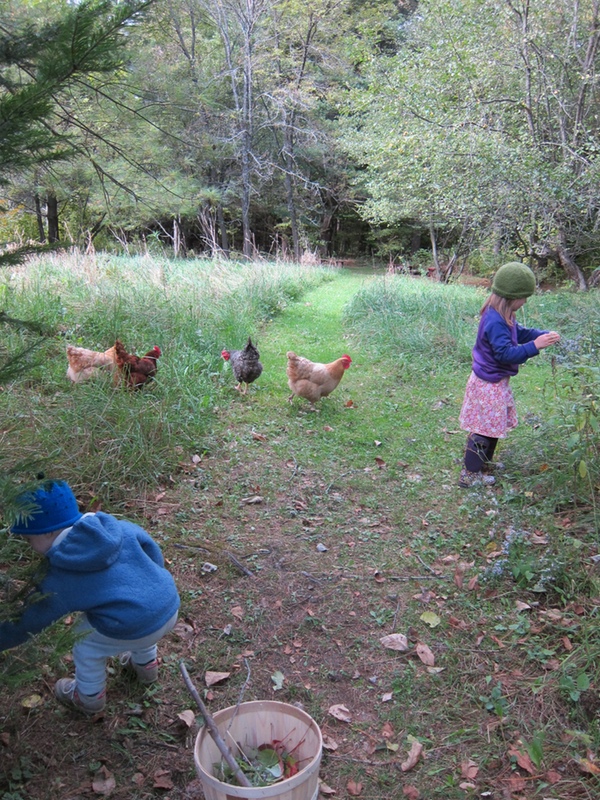
Screen time tends to be a sensitive topic that often leaves parents feeling defensive. Please note that I do not mention whether we do or do not allow screen time for our children, or if we do, what kind or how much. This post is not meant to address or judge any individual situation; rather, I am interested in exploring the topic of screen time at a more global level, and reflect on my own observations in hopes of articulating my concern about the impact of screen time on children.
----------------------------
Recently, my friend posted a link on Facebook to this article. It is a short piece in which Susan Linn argues that screen time deprives kids of the opportunity to be creative, which is detrimental to development. Here is an excerpt that captures the main point:
As with everything, there is a range of tolerance among parents when it comes to screen time. There are, of course, the two extremes – those who prohibit any screen time and those who allow a free-for-all, but most parents fall somewhere in the middle, acknowledging that screen time generally isn’t good for young children, but still allowing it in moderation due to the reality of our culture.
For example, it is pretty common for kids to watch TV here and there so the parents can take a shower in the morning, respond to an important work email, make a few quick phone calls, or prepare dinner late in the afternoon. The TV/Computer/iPhone is the perfect babysitter – it is available on demand, captivating, and free. In other words, it is a sure thing - parents can do what they need to do, knowing their kids are occupied and safe. On a day-to-day basis, it doesn’t seem like such a bad thing, to allow a little screen time in order to get things done, especially if parents are conscientious about what they allow their children to watch. Many TV shows are gentle, benign stories, and there are hundreds of educational apps that teach kids about music, nature, math, art, reading, etc. In other words, the content isn’t detrimental in any way. In fact, in the comments section of Linn’s article, some argue that screen time may even be beneficial, and that technology not only allows for creativity, but also allows for better learning.
So, assuming screen time occurs in moderation and parents carefully select screen-based activities that are age appropriate and educational, can screen time be a good thing? I think it is necessary to look at (a) what the child is getting out of screen time, (b) what the child isn’t getting out of screen time, and (c) what the child could be doing instead.
The answers will vary depending on the type of screen time. During a TV show, children passively watch a two-dimensional story play out. The benefit may be a lesson in morals (two friends work through a conflict), or the presentation of factual information (the life cycle of a butterfly). The drawback is the lack of both an imaginative component and a sense of independence. Unlike a book, which has a limited number of images for a few selected scenes of the story, a TV show provides continuous imagery covering every single moment, leaving no room for imagination. While a nature show on the life cycle of a butterfly may present valuable information, the show progresses at a set pace that does not allow the child time to focus in on and examine any one image, as he/she might choose to do when reading a book or observing a butterfly in the backyard.
For an “educational” app, however, there may be additional benefits. The child may have the opportunity to create a picture using an art app, or use problem-solving skills in a game that requires completing a puzzle to save a princess. But still, there is little room for imagination beyond what is already programmed into the app, and in addition, while children may use their hands to control what happens on the screen, they are not actually touching anything other than the keyboard, mouse, or keypad. Their sensory experience is limited to flashing lights and a repetitive audio response.
All in all, the drawbacks are not actually harmful, but the benefits are not all that impressive, especially when compared to other options, which brings us to the third, and really, the most essential question, what could the child be doing instead? Even if screen time does allow for creativity, problem solving, and imagination, what is the alternative activity? A simple example is an art app vs. drawing with crayons and paper. In an art app, children can create shapes, designs, and even elaborate pictures using a wide range of colors; it is an open-ended, creative experience. The same is true for drawing with crayons and paper, but the child also experiences valuable sensory input: the waxy smell of fresh crayons; the weight of a crayon, with broken pieces being lighter and harder to grasp than bigger pieces, and bigger pieces snapping easily if pressed too hard to the paper; the different shades one crayon can make depending on the pressure applied; the toughness of the paper as it crinkles or tears when scrubbed on; the pattern that appears through the picture from an unevenness under the paper – such as crumbs on the table or deliberately placing a leaf under the paper; the finality of the mark that cannot be erased. As adults, we take our experiential knowledge for granted, often forgetting that children do not yet know what we know. Drawing with crayons and paper offers far more information about the world than the most powerful art app.
Instead of spending time in front of a screen, a child could be building a spaceship with Legos, setting up a tea party for dolls, creating a swamp out of the living room, where the floor is quicksand and cushions are land…the possibilities are endless and they all engage problem solving, social, and physical skills. Plus, falling into a hardwood floor quicksand pit is a sensation that a screen simply can’t provide.
But perhaps even more important than the skills children are gaining through their play is the development of self-reliance. I remember the boredom of waiting rooms, restaurants, and long car rides. Because complaints of boredom were ignored, and fidgeting and impatience were considered poor behavior, my sister and I had to be resourceful. We played tic tac toe and hangman on receipts found in our mom’s purse, made fortune tellers out of napkins, perfected our cat’s cradle skills, played hand games, and made up silly guessing games and songs that got us across three states. Looking back, I realize now how firmly my parents set the expectation that they were not available to entertain us or find activities to occupy our time. The responsibility of figuring out how and what to play fell on us, not them.
Returning to the original question: can screen time be a good thing? Even though screen time in and of itself is not necessarily harmful, it’s what the child is not doing - the sensory input and physical experience that the child is not getting - during that time that can be detrimental to development. Obviously, movie night or enjoying a TV show or app here and there is not going to cause any developmental delays. But screen time so quickly becomes a habit, a quick fix for boredom, and 30-60 minutes a day – the time it takes to take a shower, answer a few emails, and make dinner – adds up pretty quickly, especially when free play is already minimal due to homework (which now seems to start in kindergarten), afterschool activities, and time spent in the car getting to and from these activities. In many cases, those 30-60 minutes a parent takes for him/herself may be the only opportunity a child has for free play… and in that case, I think screen time, no matter what the show or app, is not a good thing.
Our fall flower garden, where Goat Girl spends her time rattling poppy pods and chewing up and spitting out pansy petals (now that the raspberries and blueberries are gone); the last of the sunflowers; and for those who asked, the wood pile all neatly stacked.


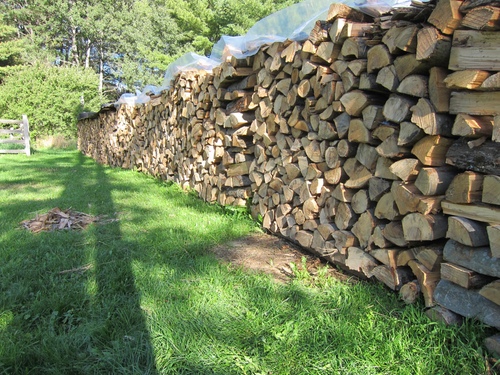
From Soulemama: A Friday ritual. A single photo - no words - capturing a moment from the week. A simple, special, extraordinary moment. A moment I want to pause, savor and remember.
